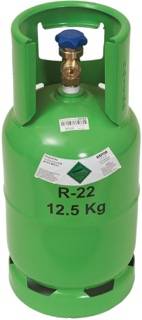The shipping industry is facing price, supply and safety risks in the run-up to the global ban on R-22 (chlorodifluoromethane or HCFC) refrigerant, warns Wilhelmsen Ships Service, a global provider of services and products. The colorless gas, which has high ozone depletion and global warming potential, is still said to be in use on between 6,000 and 8,000 vessels worldwide.
R-22 was outlawed throughout the EU in a process that ran from 2010 to January 1, 2015. It is currently being phased out in the U.S., where no new or imported R-22 will be permitted from January 1, 2020. As part of the Montreal Protocol (MP), a U.N. agreement to protect the ozone layer, HCFC use will be phased out in member countries by 2030.
“R-22 is a versatile and effective refrigerant gas that has served the shipping industry well, but it is fast approaching the end of the line,” comments Svenn Jacobsen, Technical Product Manager Refrigeration at Wilhelmsen Ships Service. “The compliance deadlines are approaching and this has, quite rightly, impacted tremendously on global production. As availability goes down price and supply risks go up, and this is potentially bad news for the owners of those remaining vessels that still use R-22.”
Industry figures indicate that legal global R-22 production this year will be only 10 percent of the volume produced in 1990. This weak supply and relatively strong demand will exert upward pressure on prices. Jacobsen believes that, if ships are slow to switch to ozone friendly refrigerant alternatives, costs “could easily double over the course of the next year.” This creates a new problem.
“When prices increase and/or availability shrinks, alternative and illegally produced products suddenly start appearing on the market,” Jacobsen states. “This is happening already, and will only increase with demand.
“Gases are being smuggled into countries, misdeclared and counterfeited. The consequences of this can be serious for vessels, catastrophic for equipment, with adulterated refrigerant causing poor mechanical performance and breakdown, and potentially deadly for individuals.”
On the latter point Jacobsen refers to the U.S., where the FBI has noted that some unapproved refrigerants contain propane, a highly flammable and explosive gas. The federal agency says that many of these substitutes are made in China and sold onwards on the black market.
The solution, Jacobsen says, is clear: “At the end of the day all vessels will have to find environmentally friendly alternatives to R-22. In the meantime, those shipowners and operators that still require it must use reliable suppliers that can provide genuine refrigerant from approved producers. This is the only way to assure quality, standards of purity and worldwide compliance.
“There are heavy fines for not complying with regulations – the EPA can assess fines of up to $37,000 a day for violations – and real risks to vessels and crews in not doing so. R-22 is on its way out; the industry has to be aware of how it can bid farewell in the safest, securest and most appropriate manner.”
In the countdown to the global ban WSS is providing the market with Unicool R-22 synthetic HCFC refrigerant, in areas where this is still permissible. The gas is used in a variety of maritime refrigeration applications for low, medium and high temperatures (-40 to +16° C).















